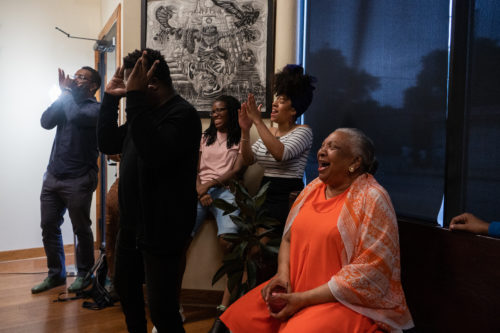
A dancer breaking chains. A woman made of petals, painted red by menstrual blood. The words “I am a revolutionary” framed by flowers.
Those are some of the images on display at a new exhibit housed at the Westside Justice Center called “Black Summer,” which launched Sunday night. A celebration of black joy, life and resistance, the exhibit is an “antidote” to the Red Summer, according to curator Kristiana Rae Colón.
“I knew that the centennial would inspire a lot of remembrance, but I think in this season of Black Lives Matter that it can easily tend towards a fetishization of violence toward black bodies, and so I just wanted to create the antidote to that,” said Colón, a poet, artist and activist who is one of the founders of the #LetUsBreatheCollective.
The summer of 1919, which people have come to know as theRed Summer, was marked by race-motivated violence that injured more than 500 and killed 38. Homes of 1,000 black families were also ruined, according to Western Illinois University historian Peter Cole. It was triggered by the murder of Eugene Williams by white teenagers when Williams accidentally crossed the imaginary border that separated the beach for white people and the area for black people. It set off a week of attacks that was mainly incited by white mobs, according to reports.
The Red Summer’s 100th anniversary was commemorated by many in Chicago through bike tours of sites of violence, performances, debates and a libation ceremony. Colón and four multidisciplinary artists created the exhibit in reaction to that and to counter misconceptions about Chicago.
“We are conjuring together a summer of vibrance and living and survival,” Colon said. “I think Chicago has been at the center of a national narrative around violence for a long time. … ‘Chiraq’ is a part of the national mythology around Chicago and that doesn’t really represent the true heart and spirit of the city, and so that is what I’m hoping to cultivate here.”
The exhibit features mixed media artwork, paintings and a wall where people can write their own “spell for joy, life and living.”
Those themes are present in B’Rael Ali Thunder’s work, which uses motifs that relate to dancing, an art form that is deeply rooted in African culture. According to Thunder, his work is an “affirmation to bring peace to black communities.”
Avery Young, one of the artists, said the exhibit investigates a “push from black death to celebrate black life.” To Young, the exhibit plays a crucial role in reminding viewers: “Those that are here are still here, in this realm, on this side of life [and] have the opportunity to change how the human experiences life.”
The exhibit will be on display until Monday, Sept. 30, at the Westside Justice Center, a nonprofit organization that provides legal services.
“To me, social justice and arts and culture will always be the rivulets of a mighty river that will always run together,” said Tanya Woods, the executive director of Westside Justice Center, who wants to make arts, culture and other resources accessible to the West Side community. “We see ‘Black Summer’ as what will be one of many exhibits to come.”
